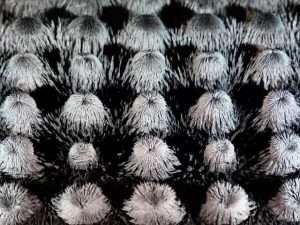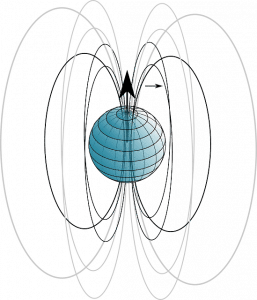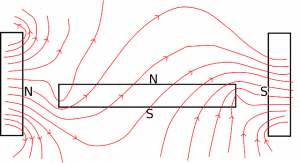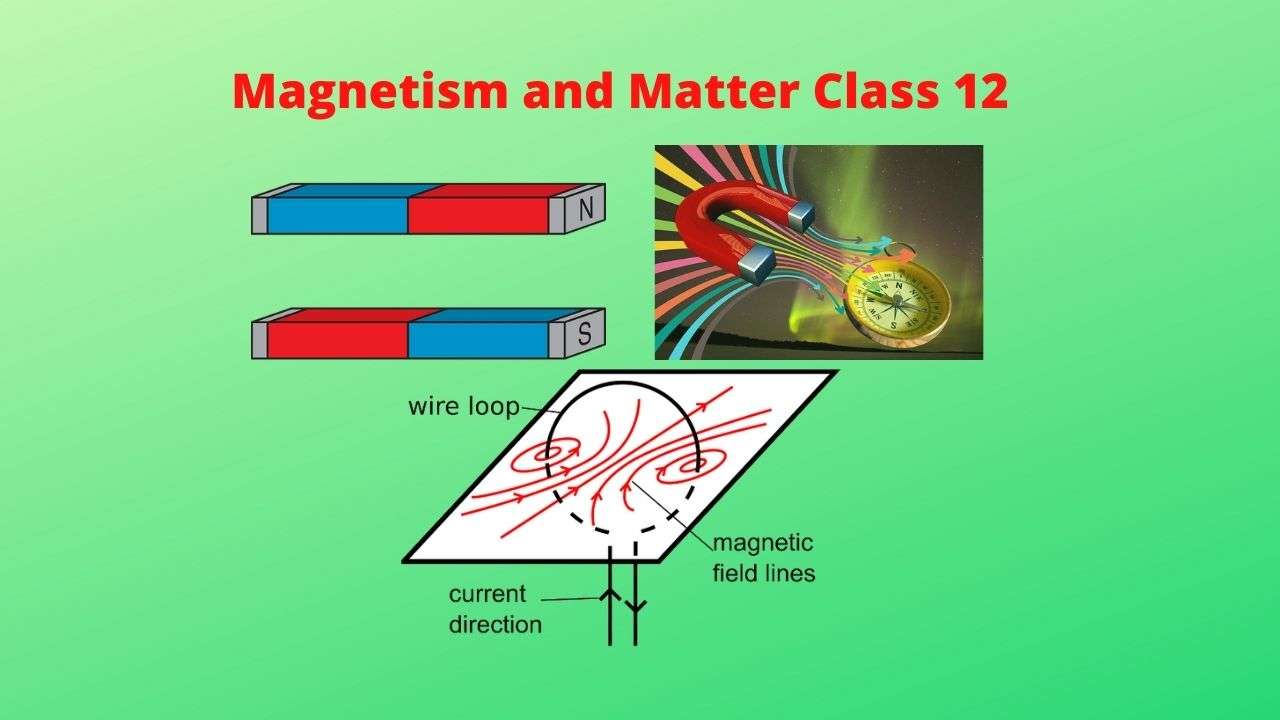Magnetism and Matter Class 12 Notes with PDF link are available below this article. The best website for CBSE students now provides magnetism and matter class 12 notes and the latest chapter-wise Revision notes for quick preparation for CBSE board exams or school-based annual examinations. CBSE Digital Education provides the best revision notes for magnetism and matter class 12. Read this article “Magnetism class 12 notes” and solve the all-important questions.
What is Magnetism?
The property of any object by virtue of which it can attract a piece of iron, cobalt, etc. is known as magnetism.

Important terms connected with magnetism
- Magnetic field: The space around a magnet within which its influence can be experienced is known as a magnetic field.
- Uniform magnetic field: A magnetic field in a region is said to be uniform if it has the same magnitude and direction at all points of that region.
- Magnetic poles: These are the regions of apparently concentrated magnetic strength in a magnet where the magnetic attraction is maximum.
- Magnetic equator: The line passing through the center of the magnet and at right angles to the magnetic axis.
- Magnetic length: The distance between the two poles of a magnet is known as the magnetic length of the magnet. It is slightly less than the geometrical length.
- Magnetic axis: The line passing through the poles of a magnet.
Natural Magnet
Natural Magnet is an ore of iron (Fe2O3) that attracts small pieces of iron, nickel, and cobalt towards it.
Permanent Magnet
It is a branch of physics in which we study the properties of bar magnets mainly.

Any bar magnet has two poles one is called the North Pole and another is called the South Pole. The North Pole is taken as a positive magnetic charge and the South Pole is taken as a negative magnetic charge.
The strength of either pole is measured by comparing the strength of the current-carrying element (idl). It is called the pole strength of the magnet of either pole. It is denoted by ‘m’. Its unit is an Ampere meter.
Magnetic Moment
The magnetic moment is defined as the product of the pole strength of either pole and the magnetic length of the bar magnet.
M = m (2l)
- The magnetic pole is a vector quantity.
- It is always directed from the South Pole to the North Pole.
- It S.I. unit = Am2
- Its Dimensional equation = IL2
Coulomb’s law in Magnetism
Two poles of the same nature repel each other and two poles of the opposite nature attract each other. The force attraction (or repulsion) between two poles is directly proportional to the product of the pole strength of each pole and inversely proportional to the square of the distance between them.
Magnetic field intensity
Magnetic field per unit North Pole or pole strength is defined as magnetic field intensity. It is a vector quantity. It is always directed along the direction of the force on test North Pole.
Magnetic field lines
Michael Faraday introduced the concept of the magnetic lines of force to represent a magnetic field visually. Magnetic lines of force don’t exist.
Magnetic lines of force originate from the North Pole (N-Pole) and terminate on the South Pole (S-pole). The tangent at any point on the lines of force indicates the direction of the magnetic field at that point inside the bar magnet.

- Magnetic lines of force are closed curve that starts in the air from the N-pole and ends at the S-pole and then return to the N-pole through the interior of the magnet.

- The lines of force never cross each other. If they do so, that would mean there are two directions of the magnetic field at the point of intersection, which is impossible.
Magnetic potential
The magnetic potential requires work to bring a unit to the North Pole from infinity to a given point. It is a scalar quantity.
Pole Strength
It can be defined as the strength of a magnetic pole to attract magnetic material toward itself. It is a scalar quantity and its SI unit is ampere-meter (A-m).
Magnetic Dipole
A magnetic dipole is an arrangement of two unlike magnetic poles of equal pole strength separated by a very small distance is called a magnetic dipole.
Magnetic Dipole Moment
The dipole moment of a magnet of a magnetic dipole is defined as the product of its pole strength and magnetic length.
- It is a vector quantity.
- It is directed from the S-pole to the N-pole.
- SI unit of magnetic dipole moment is Ampere metre2 or joule per Tesla.
m = qm x 2l
Where qm is the pole strength
And 2l is the magnetic length of the dipole from the S-pole to the N-pole.
Terrestrial Magnetism
Earth is a neutral source of the magnetic field. We have magnetic fields present everywhere near the Earth’s surface.
The magnitude and direction of this field can be obtained approximately by assuming that the earth has a magnetic dipole movement of about 8 x 1022n J/T located at its center.
The axis of this dipole makes an angle of about 11.5 degrees with the Earth’s axis of rotation.
This field arises due to the rotational motion of the earth. When a bar magnet is freely suspended near the earth’s surface, it stays in equilibrium along the Geomagnetic axis (North-South direction), the North Pole is directed due north, and the South Pole is directed due south.
We conclude that magnetic lines of force originate from the Geomagnetic South Pole and terminate on the Geo-magnetic North Pole. At either pole magnetic lines of force are vertical.
Earth’s Magnetism
Earth behaves like a huge magnet. The value of the magnetic field on the surface of the earth is a few tenths of a gauss. Earth’s magnetic strength varies from place to place on the Earth’s surface.

Experimental evidence in support of Earth’s Magnetism
- A freely suspended magnetic needle comes to rest roughly in the N-S direction.
- An iron bar buried in the earth becomes a weak magnet after some time.
- The existence of neutral points near a bar magnet indicates the presence of the Earth’s magnetic field.
Important term of Earth’s magnetism
- Geographical axis: The straight line passing through the geographical north and south poles of the earth is known as the geographical axis. It is the axis of rotation of the earth.
- Magnetic axis: The straight line passing through the magnetic north and south poles of the earth.
- Magnetic equator: It is the great circle on the earth perpendicular to the magnetic axis.
- Magnetic Meridian: A vertical plane passing through the magnetic axis is known as a magnetic meridian.
- Geographical Meridian: A vertical line passing through the geographical axis is known as a geographic meridian.
Elements of Earth’s magnetic field
- Magnetic Declination:
A plane passing through geographical poles and with the given points on the earth’s surface is called a geographical meridian. A plane passing through geomagnetic poles and with the point is called a magnetic meridian. The angle between the geographical meridian and the magnetic meridian is called the magnetic declination.
- Magnetic Inclination or Angle of Dip
The angle between the earth’s magnetic field and the horizontal direction in the magnetic meridian is called the magnetic inclination or angle of dip at that point.
- The horizontal component of the Earth’s magnetic field
It is a component of the earth’s magnetic field along a horizontal direction in the magnetic meridian. The horizontal component of the earth’s magnetic field is always directed from South to North. It is denoted by BH.
Neutral point
The point where the net magnetic field along the horizontal direction is zero is known as the neutral point. To get a neutral point of the external magnetic field should be directed from North to South and its magnetic magnitude should be equal.
Magnetic properties of matter
- Intensity of Magnetization
The magnetic moment per unit volume is defined as the intensity of magnetization.
- It is a vector quantity.
- It is always directed along the direction of the magnetic moment.
- Pole strength per unit area is also defined s the intensity of magnetization.
- Its SI unit = A/m
- Its Dimensional formula = L-1A
- Magnetic Intensity
In a vacuum, the magnetic intensity is defined as a magnetic field divided μo.
H = B/μo
For magnetic medium magnetic intensity is written as,
H = B/μo – I
Where I will be the intensity of magnetization
- Magnetic Susceptibility
For diamagnetic and paramagnetic substances, the intensity of magnetization is directly proportional to magnetic intensity.
I = X H
Where x is a constant which is called susceptibility.
X = I/H
X is positive (+ve) for paramagnetic and negative (-ve) for diamagnetic.
- Magnetic field
When a magnetic material is placed in a magnetic field, magnetism is induced in it.
The magnetic field that exists in a vacuum and induces magnetism is known as the magnetizing field.
- Magnetic induction
Magnetic induction may be defined as the number of magnetic lines of force crossing per unit area normally through a material.
- Magnetic field intensity
The ability of the magnetizing field to magnetize a material medium is expressed by a vector H.
- Magnetic permeability
The magnetic permeability of a material may be defined as the ratio of its magnetic induction B to the magnetic intensity H.
- Relative permeability
Relative permeability is defined as the ratio of the permeability of the medium to the permeability of free space.
Curie’s laws
For paramagnetic substances, magnetic susceptibility is inversely proportional to absolute temperature.
X is proportional to 1/T
X = C/T
Where ‘C’ is a constant, it is called Curie’s constant.
When the temperature of a ferromagnetic substance is increased, it becomes paramagnetic at a certain temperature. Curie temperature of iron is 1043k.
Classification of Magnetic Materials
- Diamagnetic substances
- Paramagnetic substances
- Ferromagnetic substances
Diamagnetic Substances
Those substances when placed in a magnetic field it gets magnetized opposite to the direction of the magnetizing field (external field). Thus, the net field inside the materials is smaller than the external field; such a substance is called a diamagnetic substance.
- When it is placed in a non-uniform magnetic field, it has a tendency to move from the stronger to the weaker part of the magnetic field.
- It is independent of temperature.
- Its susceptibility is negative.
- Examples: copper, zinc, silver, gold, lead, glass, marble, water, helium, argon, etc.
Paramagnetic substances
When such a substance is placed in a magnetic field, it gets magnetized along the direction of the magnetizing field. Thus net field inside the material becomes greater than the magnetizing field. Such a substance is called a paramagnetic substance.
- When it is placed in a non-uniform magnetic field, it tends to move from the weaker to the stronger part of the magnetic field.
- It depends on the temperature.
- Its susceptibility has a small positive value.
- Examples: aluminum, sodium, antimony, copper chloride, manganese, chromium, liquid oxygen, etc.
Ferromagnetic Substances
When a substance is placed in a magnetic field, it is strongly magnetized along the direction of the magnetizing field. Thus net magnetic field inside the material becomes much greater than the magnetizing field. Such material is ferromagnetic material and permanent magnets are made from them.
- When it is placed in a non-uniform magnetic field. It has a strong tendency to move from the weaker part to the stronger part of the magnetic field.
- It depends on the temperature. At a particular temperature, a ferromagnetic substance is converted into paramagnetic one. This temperature is called the Curie temperature.
- Examples: Iron, Nickel, Cobalt, etc.
Hysteresis loop
When a demagnetized material (soft iron) is placed in B-field, the material gets magnetized along the direction of the external field (magnetizing field).
When the external field is increased, the intensity of magnetization increase to the maximum value, it is represented by Curve ‘OA’
When the external field is decreased to zero, the intensity of magnetization is not zero. It is represented by the curve ‘AC’.
The intensity of magnetization (OC) in the absence of an external field is called retentivity of material or residual magnetism.
When the external field is increased along the opposite direction, the material gets demagnetized at a certain value of the external field, the required external field (OD) in the opposite direction to demagnetize the material is called backward coercive force.
If the external field is further increased, the intensity of magnetization increases to the maximum value in the opposite direction. The same process is repeated by reversing the direction of the external field.
The larger the area of the loop, the larger will be the heat produced.
OD = Backward Coercive force
OG = Forward Coercive force.
Selection of magnetic materials
- Permanent magnets
The material used for making permanent magnets must have the following properties:
- High retentivity so that it produces a strong magnetic field.
- High permeability
- High coercivity so that its magnetization is not destroyed by stray magnetic fields, temperature variations, or minor mechanical damage.
- Electromagnets
The material used for making cores of electromagnets must have the following properties:
- High initial permeability
- Low retentivity
- Transfer of cores
The materials used for making cores of electromagnets must have the following properties:
- High initial permeability
- Low retentivity
- Low hysteresis loop
Electromagnets
Take a soft iron rod and wind a large number of turns of insulated copper wires over it. When we pass the current through the solenoid, a magnetic field is set up in the space within the solenoid. The high permeability of soft iron increases the field 1000 times. The end of the solenoid at which the current in the solenoid seems to flow anticlockwise acts as the North Pole and another one as the South Pole. When the current in the solenoid is switched off, the soft iron rod loses its magnetism almost completely due to its low retentivity.
Uses of Electromagnets
- It is used in electric bells, loudspeakers, and telephone diaphragms.
- Large electromagnets are used in cranes to lift heavy machinery and bulk quantities of iron and steel.
- In hospitals, electromagnets are used to remove iron or steel bullets from the human body.
Frequently Asked Questions (FAQ)
- What is coercivity?
Answer: The value of the reverse magnetizing field that should be applied to a given sample in order to reduce its intensity of magnetization or magnetic induction to zero is known as coercivity.
- What is retentivity or residue magnetism?
Answer: The value of the intensity of magnetization of material, when the magnetizing field is reduced to zero is known as retentivity or residue magnetism of the material.
I hope you like this article about Magnetism and Matter Class 12. Comment below for doubt related to this chapter Magnetism and Matter class 12.
